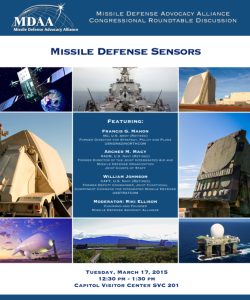|
Amongst the defense budget hearings this week in Congress, the Missile Defense Advocacy Alliance held an open roundtable discussion on Missile Defense Sensors, a key component that drives confidence in the nation’s missile defense capability, with notable experts at the United States Capitol who emphasized the universal fundamental axiom “If you can’t see it, you can’t hit it.” This event was based on the notionally simple, yet technologically complex sensors that are the vital component of successfully finding and tracking a lethal object (a nuclear warhead), at hypersonic speeds in space among a widening cluster of debris, countermeasures and decoys created by release of the warhead payload and space junk during and after the rocket’s last stage burnout. Volumes and volumes of data are collected by these multiple sensors with different wavelength propagations on land and sea based sensor platforms that are fused together and repeatedly sent back and forth to continue to find the best sensor track available to create the optimal firing solution. To achieve the highest confidence and to reduce the number of interceptors needed (shot doctrine) from a limited supply, a firing solution provided by sensors must tell the interceptor precisely where it needs to be, what time it needs to be there, which way it needs to look and In today’s U.S. missile defense architecture, designed primarily against the ballistic missile threat of North Korea to the United States, there remains gaps in sensor coverage, sensor persistence and sensor discrimination that directly affect the reliability of the 30 currently deployed ground based interceptors in Alaska and California. The United States does have persistent tracking sensors forward-based, but they get flown over early in a ballistic missile’s flight, therefore do not have the capacity or capability to track the missile from birth to death. The only designed, developed and deployed long rang discriminating sensor for U.S. homeland defense today is the Sea-Based X-Band Radar (SBX). Built as a testing platform, home-ported in Hawaii, the SBX has to be put out to sea and positioned correctly, which takes tremendous amount of valuable time prior to a possible launch. The SBX is not considered a persistent sensor, nor can it provide discrimination information for North America from its base in Hawaii. The SBX does serve today to defend Hawaii when it’s put out to sea, in its discrimination capacity against North Korea. At close to $25 million a month to operate when deployed, it remains a key testing platform and in emergency situations with lead time provides long-range discrimination against North Korea. With North Korea’s recent pattern of “no notice” launches and its development of road-mobile ballistic missiles, not having a persistent long-range discriminating radar for Hawaii and North America is a serious national security challenge for the United States. It is of absolute necessity for the best defense of the United States to acquire, build and deploy a persistent Long Range Discrimination Radar, placed in Alaska in protection of North America to track, discriminate and find lethal objects coming across the vast areas of the Pacific towards the United States. Our featured experts were Rear Admiral (USN, ret) Archer Macy, former Director of the Joint Integrated Air and Missile Defense Organization; Major General (USA, ret) Francis Mahon, Former NORAD/NORTHCOM Director for Strategy Policy and Plans; Captain William Johnson (USN, ret), Former Deputy Commander of the Joint Functional Component Command for Integrated Missile Defense. Click here for audio of MDAA’s Congressional Roundtable on Missile Defense Sensors. A full transcript will be available soon.
Riki Ellison
|

